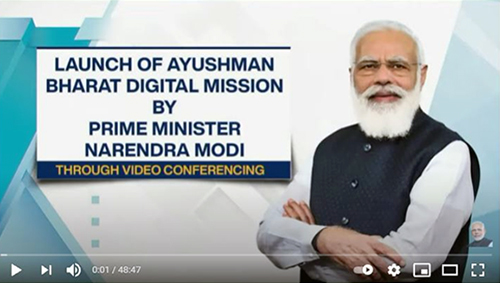
The launch of the Ayushman Bharat Digital Mission, with the goal of fusing the various and separate digital health systems already in existence into a National Digital Health Ecosystem, was announced by Prime Minister Narendra Modi on September 27, 2021.
Ayushman Bharat Digital Mission (ABDM)
- Currently, there are five primary parts of the ABDM:
- Account number for Ayushman Bharat Health (ABHA): a special identification code for health,
- Registrar of Healthcare Professionals (HPR) a database of medical experts from both conventional and innovative systems of care,
- Hospitals, clinics, diagnostic centres, and pharmacies are all listed in the Health Facility Registry (HFR), a database of both public and commercial healthcare facilities.
- UHI, or Unified Health Interface: An open protocol connecting patients and healthcare providers for digital health services,
- the ABHA mobile app a mobile application that enables the carrying of electronic health records.
Future of India’s healthcare system
- Government push for digitization: The Indian government has made significant efforts to promote the digitization of the healthcare sector in order to make health accessible, affordable, and fairly distributed. This is done in order to achieve the Sustainable Development Goals and targets of universal health coverage.
- The two registers would allegedly produce a database of India’s healthcare facilities and professionals that citizens would be able to access. Doctors can also access the health registry.
- Digital health card: With the ABHA number and the accompanying application, people can carry their medical records to any healthcare facility and securely identify themselves.
- Finally, the UHI would promote improved access to and the provision of targeted healthcare services.
- Huge amounts of data will be generated as a result of all of this activity, and these data will be essential for research, innovation, and policymaking.
Importance of private sector in health sector
- India has a mixed healthcare system, which means that both public and private healthcare services are available there. The ABDM won’t be able to accomplish its goals without the private healthcare industry’s active involvement.
- 81% of doctors in India work for the private sector, which also supplies 81% of the country’s doctors. Private healthcare infrastructure makes up almost 62% of all of India’s health infrastructure.
- Preference for private healthcare: Indians in both urban and rural areas appear to prefer receiving care from the private sector. Only 33% of rural people and 26% of urban people rely on the public sector for healthcare.
@the-end
It is unclear whether the government plans to use mandates or incentives to encourage private sector engagement. Without either strategy, it appears that fewer smaller private healthcare providers will participate in the ABDM, however it is unclear how this will turn out.
